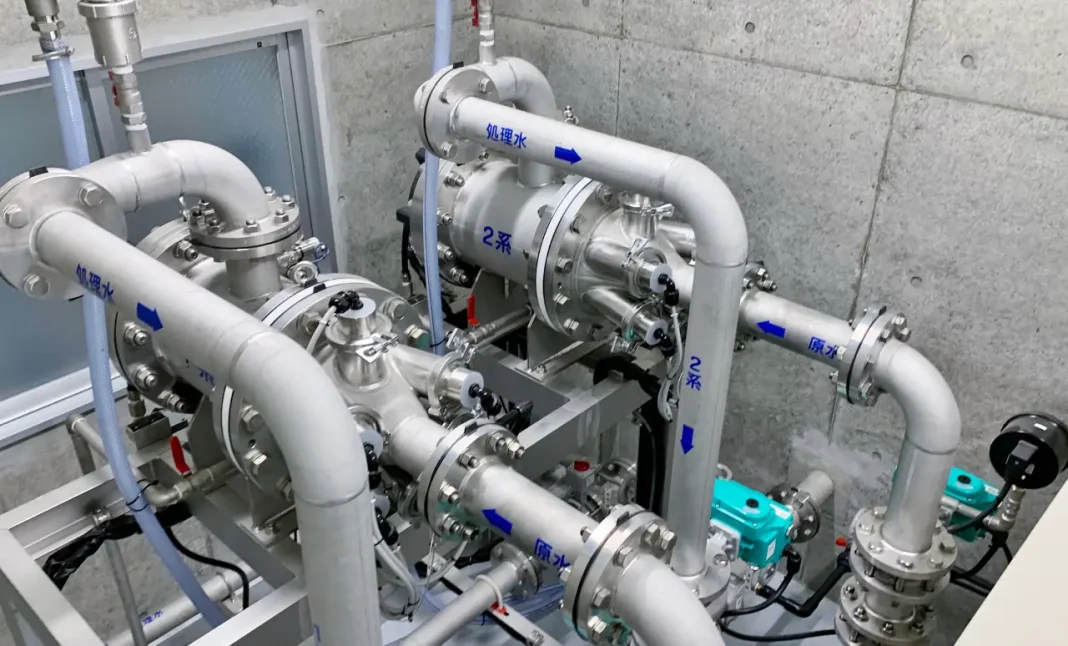Takahito Sugimoto, Water Supply Engineering Department, METAWATER Co., Ltd.
Yoshiro Kanto, International Business Planning Department, METAWATER Co., Ltd
METAWATER Co., Tokyo, Japan, developed a deep ultraviolet (UV) LED system (also referred to as DUV LED or UV-C LED) for municipal water treatment. The first DUV LED disinfection system (300 m3/day x 2 units) was installed in a municipal drinking water treatment plant in Ka-goshima Prefecture, Japan, in February 2019. At that time, the following were the reasons for the introduction:
- Small footprint
- Long life of light source: 15 years LCC (lifecycle cost), which is equivalent to low-pressure UV lamp products
- The number and frequency of replacement parts are small and maintenance is easy.
As of December 2019, the equipment has been running smoothly, and results will continue to be collected.
Background of development
METAWATER started developing a UV irradiation/disinfection device using DUV LED in 2015. At that time, laws and regulations were being developed in Japan to comply with the Minamata Convention on Mercury (hereinafter referred to as the Minamata Convention). Since the Minamata Convention was expected to take effect, mercury-based products in various fields were supposed to be restricted, and studies on a variety of mercury-free light sources also had begun in water treatment using UV irradiation devices.
DUV LED as a mercury-free light source
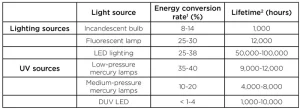
Among the mercury-free light sources, deep UV LED was given the most attention. The efficiency of each light source is as shown in Table 1. For lighting applications, the energy conversion efficiency of LEDs is equal to or higher than that of fluorescent lamps (ultraviolet lamp + fluorescent coating), and the lifetime is four to eight times longer. It is clear that LEDs have an overwhelming advantage.
However, both the efficiency and the service life are reference values and vary depending on product performance and use environment.
On the other hand, the DUV LED (ultraviolet light source) already has achieved a rated life of 10,000 hours, which is equivalent to that of a low-pressure mercury lamp, but its energy conversion efficiency is still less than 4%, which is lower than other light sources. However, the theoretical energy conversion efficiency would be equivalent to that of LEDs for lighting, and it can be said that the current DUV LED is still in the early stages and is a light source filled with possibilities.
Believing the future of DUV LED to be very promising, DUV LED was adopted as the mercury-free light source for the new equipment.
Future of DUV LED
If the energy conversion efficiency of DUV LEDs is equivalent to that of lighting LEDs, the following advantages will be achieved over conventional UV lamps in addition to the advantages of lighting LED over fluorescent lamps:
- Easy electrical control (output modulation, start/stop, etc.)
- Good responsiveness (instant full power output)
- Lamp life is not affected by frequent on /off cycle
- No heat in light emission (LED photon emission is from different surface of heat emission)
- Flexible design and layout
- High output and long service life
However, at present, among the above advantages, high output and long service life has not been realized. In the development of the product, it was an objective to minimize the impact of those and take measures to maximize the advantage.
UV LED irradiation spectrum
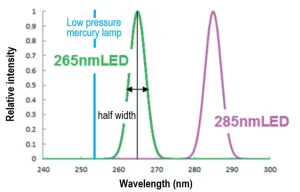
As shown in Figure 1, UV lamps have a sharp emission line spectrum at 253.7 nm, while LEDs have a broad spectrum expressed by the peak wavelength and half width.2 DUV LEDs are broadly classified into two types of peak wavelengths due to the difference in materials. One has a peak near 285 nm and the other has a peak near 265 nm.
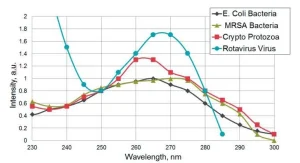
Figure 2 shows the wavelength dependence of the bactericidal effect on typical microorganisms. It is known that the bactericidal effect is maximal around 260 to 270 nm, which is near the peak of the absorption wavelength of DNA, when the output is the same.2 However, current DUV LEDs tend to have lower energy conversion efficiency and shorter lifetime at shorter wavelengths. For this reason, the disinfection effect (spectral sensitivity) on the input power is most advantageous around 280 nm as shown in Figure 3.4 For the time being, DUV LEDs, which have a peak at around 280 nm, are considered to be advantageous in terms of manufacturing cost and life and have been adopted for products.
Overview of equipment
Light source module
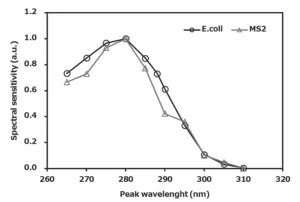
Currently, the output of one DUV LED lamp package is small, and it is necessary to mount many devices. In addition, heat dissipation for the package is critical. At first, it was considered that it could be housed in a cylindrical shape like a mercury lamp. However, since this structure is complicated for heat dissipation, a planar light source was used for the product in consideration of maintainability.
By integrating the LED packages on a flat surface, the cooling mechanism and cables may be combined and dew condensation prevention and better maintenance can be easily achieved.
Because the irradiated light is attenuated by reflection, it is better to extend the optical path length without reflecting as long as possible in order to improve the irradiation efficiency. However, since the orientation angle of the DUV LED chip is quite wide, UV light reflected on the inner cylinder increases. Therefore, the optical path length of more light rays is extended by using a highly reflective material reflector having a low attenuation rate.
UV reactor design
As described previously, it is preferable to increase the optical path length in order to increase the irradiation effect. Furthermore, for water flow, it is necessary to reduce the possibility of short-circuiting within the reactor to produce a uniform flow.
If the influent water can short-circuit within the reactor, it does not get the required UV dose, and if the water is excessively retained in the reactor, exceeding a certain level of applied UV dose does not contribute to the improvement of the overall disinfection effect. Therefore, it is essential to improve the efficiency of the disinfection system by giving a uniform and higher irradiation dose.
The length of the reactor was based upon the optimum distance between the irradiation source and the ultrasonic cleaning devices, taking into account the light penetration distance of the DUV LEDs at the design UV transmissivity.
Light source cooling system
The DUV LED’s performance (irradiation dose, lifetime, etc.) is dependent on the lamp temperature, so it is important to make the temperature distribution as uniform as possible and operate within the specified temperature range for the individual LED chips.
In the case where a DUV LED is integrated as a surface light source, there is a problem that even if an air-cooled type of heat sink is provided, a large amount of air contact is needed because the heat capacity of the air is small, and, as a result, the temperature tends to be uneven. Therefore, a heat sink designed to adopt a water-cooled system was used. This improved the heat exchange efficiency from the substrate and reduced the temperature difference over the entire light source.
Additionally, raw water was used as cooling water for the heat sink, so additional water was unnecessary.
Performance and features of the developed product
The product using UV LED as a light source has the following features as compared to a low-pressure UV lamp:
- Excellent ON/OFF resistance
- Good response (100% output instantaneously)
- There is no restriction of operation control for the reasons of reference 1 and 2
- Light source life achieved 70,000 hours by power output control, which is five times more than low-pressure UV lamps
- Since it is a planar light source, it can be replaced easily
- Small maintenance space as compared to mercury lamp products
Table 2 summarizes the comparison of LED with low-pressure UV lamp.
Conclusion
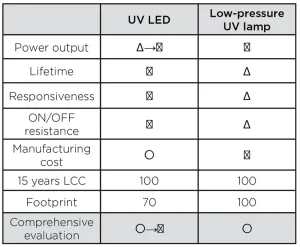
In the future, if the performance of DUV LEDs is improved and the resulting products become more popular, the replacement of existing mercury-based UV lamp equipment may be accelerated.
METAWATER will continue to expand the lineup of DUV LED irradiation equipment while developing larger capacity products and simultaneously optimize the reactor design, taking advantage of the higher output power of the LED package to further reduce both capital and operational cost of the DUV LED systems.
Contact: sugimoto-takahito@metawater.co.jp; kanto-yoshihiro@metawater.co.jp
References
- Optronics Editor, 2016, UV-LED application to water treatment accelerated, Monthly OPTRONICS June 2016
- Nagase Kazuhiro, 2018, Disinfection application of UVC-LED, JUVA Newsletter No.11, 013.
- Shinya Watanabe, 2018, Application of UVC-LED for disinfection, JUVA Newsletter No.11, 014.


